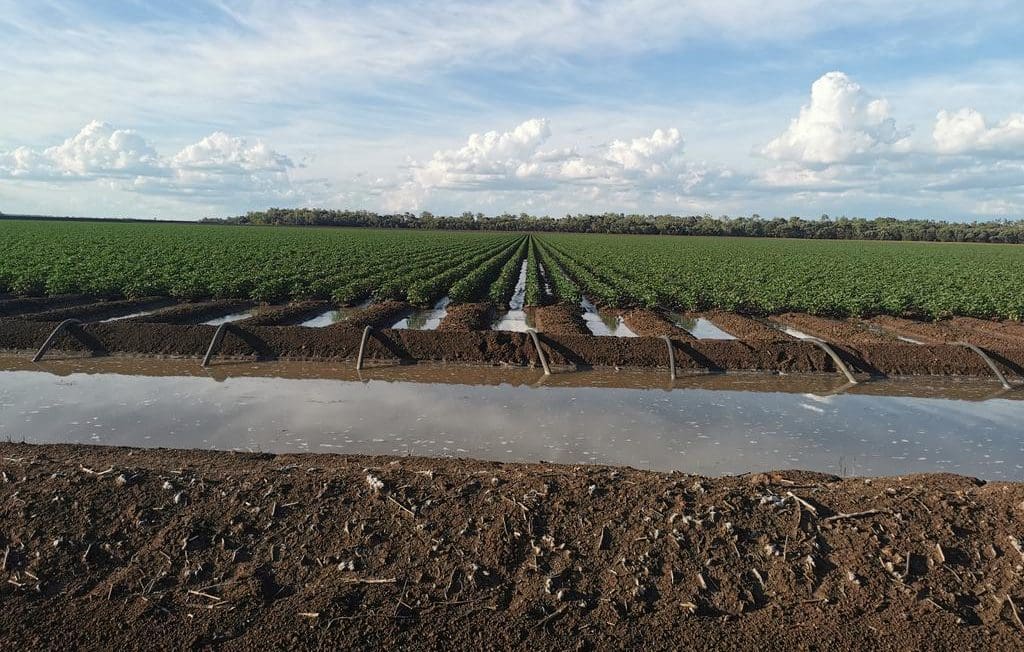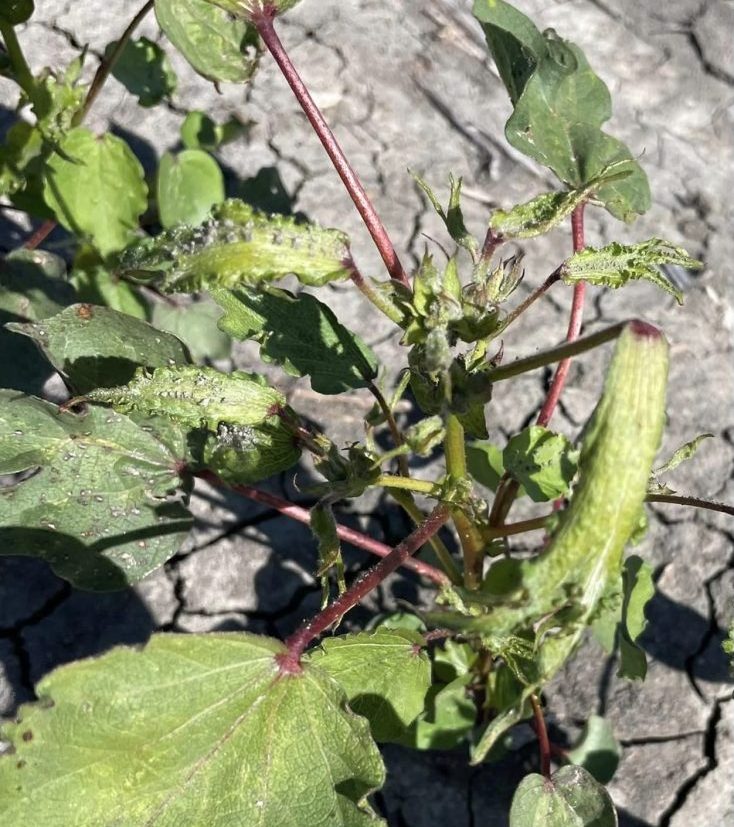
This cotton crop at Springsure in Central Queensland is thriving thanks to a huge jump in the region’s water allocation. It was planted on November 11. Photo: Roland Hornick
COTTON planting is well advanced across eastern Australia, with the crop size predicted to be substantially reduced in NSW due to prolonged flooding and rainfall, while Queensland likely to see increased area compared to last season.
Currently Cotton Australia is forecasting Queensland to produce almost 2 million bales (Mb) this season, up from 1.8Mb in 2021-22.
According to ABARES Australian Crop Report released last month NSW is facing a 40pc drop in production,
All Queensland growing regions have seen jumps in hectares planted from last season.
The largest gain came from Dirranbandi which has around 26,000ha planted, more than double last season’s area of 12,000ha.
Other notable increases have come from the Darling Downs with 68,000ha planted up from 56,000ha and the St George region at 27,000ha up from 22,000ha.
The Central Highlands is expected to have the largest crop in several years with additional mid-season water allocations seeing area jump to about 17,500ha.
Cotton Australia general manager Michael Murray said the sentiment was positive from growers across all Queensland growing regions.
“We are looking slightly better than last year; obviously a lot can happen between now and harvest, but it is looking good at the moment,” Mr Murray said.
“It is certainly comparable, if not a slightly larger crop, than last year for Queensland.
“The general vibe I am getting from growers is that after a relatively slow start, particularly on the Downs and out west, the crops are really hitting their stride.
“People are happy with their progress at the moment.”
Crops overcome late start
Based in Goondiwindi, MCA director Tim Richards said there was “big variations in growth” in southern Queensland, primarily due to when the crop was planted.
He said due to a near-record cold start, crops were behind by least two weeks but were making the most of the current warm, sunny conditions.
“It was hard to get in early as it was quite cool and that held things back,” Mr Richards said.
“The plants that were planted earlier are really shaping up and the late ones are starting to make ground with this good weather.
“It is pretty positive, and it is improving each week.”
With months left until harvest, Mr Richards said the later-planted crops still needed a “good finish” to ensure optimal yields and quality.
“With the later ones that had a slow start, it is now up to whether we can accumulate enough heat units to grow the crop.
“They are still on a bit of a knife’s edge and need good weather right through the summer.”
Some dryland growers suffer
Thanks to full water storages, irrigated growers are in an ideal position to capitalise on the above-average rainfall seen across the Downs in the past two years.
Conditions aren’t as idyllic for some dryland growers who are now hoping for top-up rain to fall in coming weeks.
Bongeen dryland grower John Cameron said his crop was crying out for about 50mm of rain.
“Part of the farm had 20-30mm in a storm last week and part of the farm looks beautiful and really powering,” Mr Cameron said.
“The rest of it is still sitting on reasonable moisture but could do with a drink…about 50mm of rain would be very welcome.”
Mr Richards said he has spoken to dryland growers in the Goondiwindi region who, like Mr Cameron, need rain to keep later-planted summer crops thriving.
“The Downs have been wetter over these past two months and anything south of there has had very little rain.”

Located on the NSW-Queensland border, it is the worst incident of spray drift that the owners of Evolution Farms have experienced. Photo: Evolution Farms
Widespread spray drift reports
Alongside concerns over upcoming weather conditions, many growers are also grappling with widespread spray-drift damage to crops.
Mr Murray said recent severe incidents of spray drift in southern Queensland have put a black mark on the generally positive start to the season.
“We have certainly had a number of significant spray-drift incidents right across southern Queensland and that is extremely disappointing.
“The actual impact on the crop is too hard to tell at this stage.”
Evolution Farms, located at Mungindi on the NSW-Queensland border, have reported severe incidents of spray drift on their property.
The damage reportedly first appeared in December with some crops not surviving the chemical spray.
Mr Richards said he has also witnessed widespread spray drift, but thankfully the earlier planted crops were mostly unscathed.
“We were expecting it; obviously a lot of fallows came out of harvest and that is when it happens and when people are up against it getting jobs done.”
Mr Richards said spray drift incidents were very prevalent in seasons like this “there wouldn’t be a farm without some symptoms of Group 1”.
“Definitely there would be some people who are quite anxious about what has happened, but overall, with our clientele, they have pushed through it quite quickly.”
Water props up CQ
Rainfall in parts of Central Queensland in the middle of the planting window was a welcome relief for growers who have since had their water allocation increased to 100pc.
Iker Ag Consulting agronomist Belinda Chase said extra water encouraged growers to plant larger areas from September to December 31 and bumped up the region’s overall crop size.
“Up here if you have water…there is probably nothing that comes close to cotton at the current prices,” Ms Chase said.
“It has definitely been a driver for a lot of guys putting mostly cotton into the irrigation.
“Of what we look after, 95pc of the irrigation would be cotton, there would be a few mungbeans and things, but it is pretty much all cotton.”
Emerald grower Renee Anderson said water has prompted her to plant cotton over other crops, like mungbeans.
She said growers in her district started the season with no allocation, which was bumped up to 4pc in August and gave some incentive to plant.
“There wasn’t much area in then as 4pc isn’t a lot,” Ms Anderson said.
“Then we had some rain across the district which was very exciting to see.”
She said this rain saw the meagre allocation rise to 100pc, which spurred growers to plant larger areas.
“It’s the most that we have had in in a really long time, so it is pretty exciting.”
Some condition issues
Ms Chase said the earlier planted cotton did suffer from cooler temperatures and was slower to develop, but most are progressing well.
“We did have a slower crop and then until two weeks ago we had pretty high persistent insect pressure.
“So we have been pushing the proverbial up the hill a bit as far as sticking fruit and things.”
She said the earlier crop was still “set up to be a nice crop” and should yield well.
She said the later crop, which is set to be picked in April, was still reliant on weather conditions before its quality and yields are known.
Cotton Australia is currently predicting the Australian 2022-23 cotton crop to be more than 5Mb.
It is greater than the ABARES December figure of just 4.3Mb, but on par with Cotton Compass’ estimate of 4.9Mb from November.
Despite coming in lower than previous expectations of 5-5.5Mb, the crop is still likely to be in the top five largest ever for the Australian industry.
Grain Central: Get our free news straight to your inbox – Click here

HAVE YOUR SAY